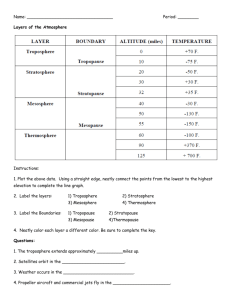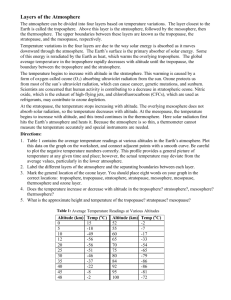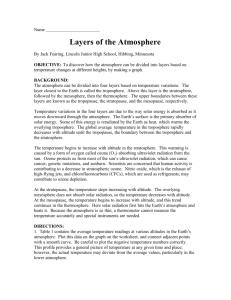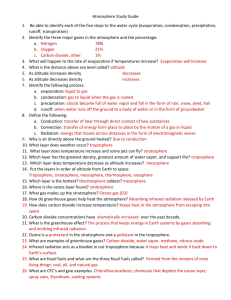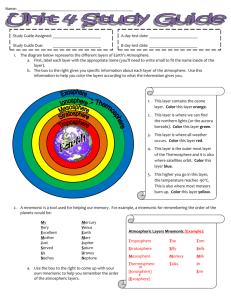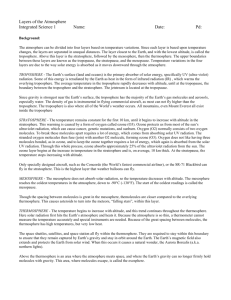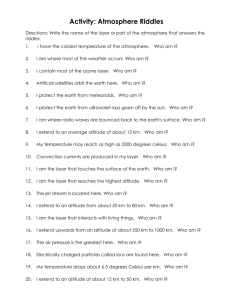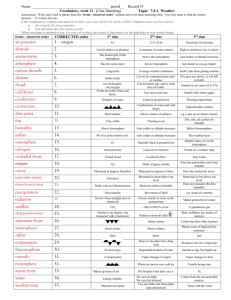Graphing - Dillon Environmental Science
advertisement
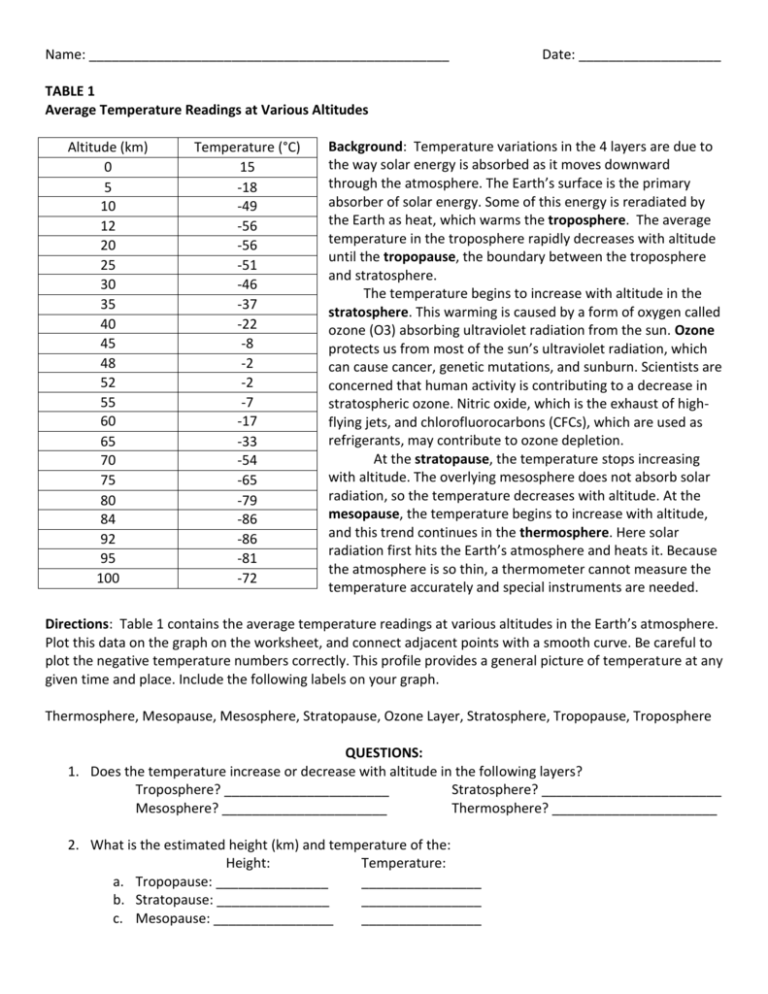
Name: ________________________________________________ Date: ___________________ TABLE 1 Average Temperature Readings at Various Altitudes Altitude (km) 0 5 10 12 20 25 30 35 40 45 48 52 55 60 65 70 75 80 84 92 95 100 Temperature (°C) 15 -18 -49 -56 -56 -51 -46 -37 -22 -8 -2 -2 -7 -17 -33 -54 -65 -79 -86 -86 -81 -72 Background: Temperature variations in the 4 layers are due to the way solar energy is absorbed as it moves downward through the atmosphere. The Earth’s surface is the primary absorber of solar energy. Some of this energy is reradiated by the Earth as heat, which warms the troposphere. The average temperature in the troposphere rapidly decreases with altitude until the tropopause, the boundary between the troposphere and stratosphere. The temperature begins to increase with altitude in the stratosphere. This warming is caused by a form of oxygen called ozone (O3) absorbing ultraviolet radiation from the sun. Ozone protects us from most of the sun’s ultraviolet radiation, which can cause cancer, genetic mutations, and sunburn. Scientists are concerned that human activity is contributing to a decrease in stratospheric ozone. Nitric oxide, which is the exhaust of highflying jets, and chlorofluorocarbons (CFCs), which are used as refrigerants, may contribute to ozone depletion. At the stratopause, the temperature stops increasing with altitude. The overlying mesosphere does not absorb solar radiation, so the temperature decreases with altitude. At the mesopause, the temperature begins to increase with altitude, and this trend continues in the thermosphere. Here solar radiation first hits the Earth’s atmosphere and heats it. Because the atmosphere is so thin, a thermometer cannot measure the temperature accurately and special instruments are needed. Directions: Table 1 contains the average temperature readings at various altitudes in the Earth’s atmosphere. Plot this data on the graph on the worksheet, and connect adjacent points with a smooth curve. Be careful to plot the negative temperature numbers correctly. This profile provides a general picture of temperature at any given time and place. Include the following labels on your graph. Thermosphere, Mesopause, Mesosphere, Stratopause, Ozone Layer, Stratosphere, Tropopause, Troposphere QUESTIONS: 1. Does the temperature increase or decrease with altitude in the following layers? Troposphere? ______________________ Stratosphere? ________________________ Mesosphere? ______________________ Thermosphere? ______________________ 2. What is the estimated height (km) and temperature of the: Height: Temperature: a. Tropopause: _______________ ________________ b. Stratopause: _______________ ________________ c. Mesopause: ________________ ________________ Name: ________________________________________________ Date: ___________________ TABLE 1 Average Temperature Readings at Various Altitudes Altitude (km) 0 5 10 12 20 25 30 35 40 45 48 52 55 60 65 70 75 80 84 92 95 100 Temperature (°C) 15 -18 -49 -56 -56 -51 -46 -37 -22 -8 -2 -2 -7 -17 -33 -54 -65 -79 -86 -86 -81 -72 Background: Temperature variations in the 4 layers are due to the way solar energy is absorbed as it moves downward through the atmosphere. The Earth’s surface is the primary absorber of solar energy. Some of this energy is reradiated by the Earth as heat, which warms the troposphere. The average temperature in the troposphere rapidly decreases with altitude until the tropopause, the boundary between the troposphere and stratosphere. The temperature begins to increase with altitude in the stratosphere. This warming is caused by a form of oxygen called ozone (O3) absorbing ultraviolet radiation from the sun. Ozone protects us from most of the sun’s ultraviolet radiation, which can cause cancer, genetic mutations, and sunburn. Scientists are concerned that human activity is contributing to a decrease in stratospheric ozone. Nitric oxide, which is the exhaust of highflying jets, and chlorofluorocarbons (CFCs), which are used as refrigerants, may contribute to ozone depletion. At the stratopause, the temperature stops increasing with altitude. The overlying mesosphere does not absorb solar radiation, so the temperature decreases with altitude. At the mesopause, the temperature begins to increase with altitude, and this trend continues in the thermosphere. Here solar radiation first hits the Earth’s atmosphere and heats it. Because the atmosphere is so thin, a thermometer cannot measure the temperature accurately and special instruments are needed. Directions: Table 1 contains the average temperature readings at various altitudes in the Earth’s atmosphere. Plot this data on the graph on the worksheet, and connect adjacent points with a smooth curve. Be careful to plot the negative temperature numbers correctly. This profile provides a general picture of temperature at any given time and place. Include the following labels on your graph. Thermosphere, Mesopause, Mesosphere, Stratopause, Ozone Layer, Stratosphere, Tropopause, Troposphere QUESTIONS: 1. Does the temperature increase or decrease with altitude in the following layers? Troposphere? ______________________ Stratosphere? ________________________ Mesosphere? ______________________ Thermosphere? ______________________ 2. What is the estimated height (km) and temperature of the: Height: Temperature: a. Tropopause: _______________ ________________ b. Stratopause: _______________ ________________ c. Mesopause: ________________ ________________
